#Zhiju/直裾
Photo

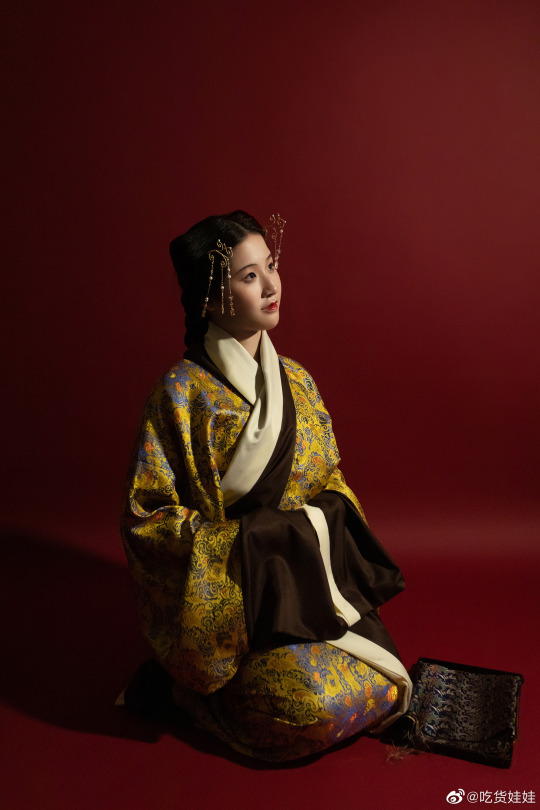
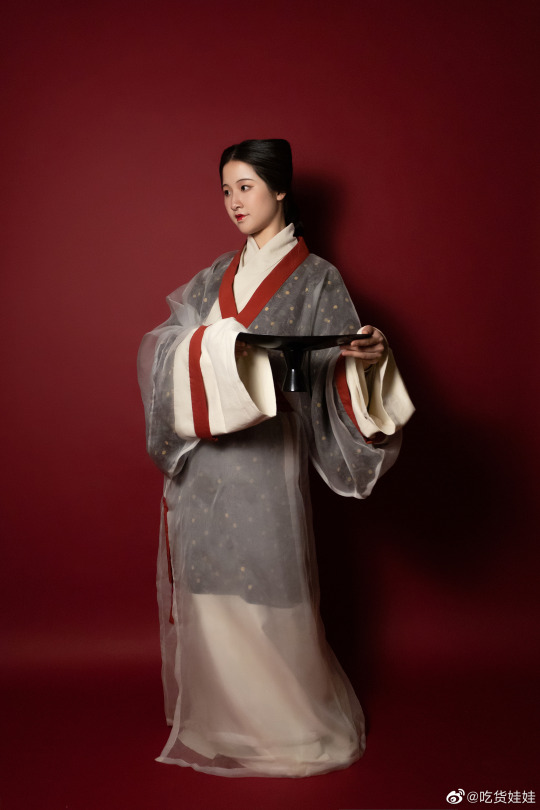


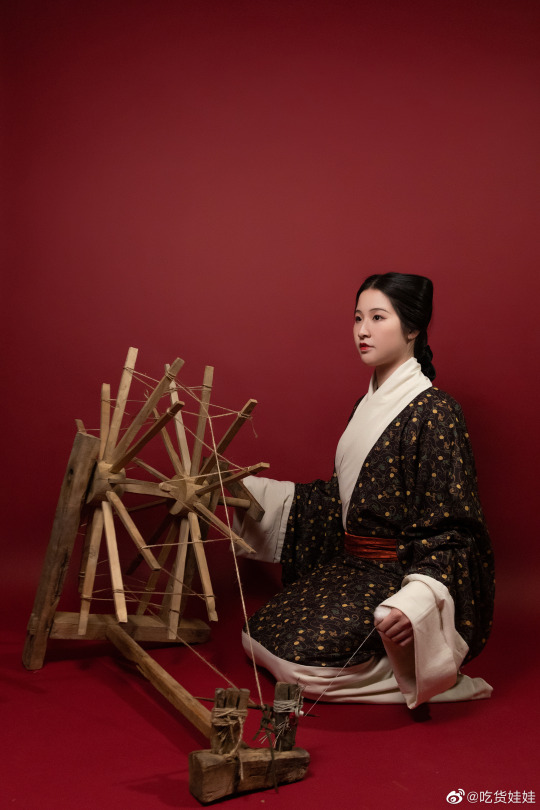




【Historical Artifacts Reference】
China Western Han Dynasty(206 BCE–9 CE)Female Figurines


Robes (”Quju/曲裾” & Zhiju/直裾”) of silk, cotton and Plain yarn garment(素纱襌衣)from the Mawangdui Tombs belonging to Xin Zhui(辛追), Marquess of Dai - c. 217 BC-168 BC, Western Han Dynasty, China
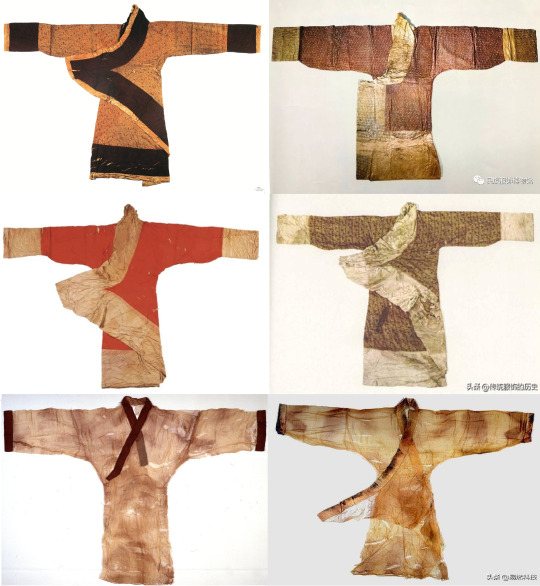
[Hanfu · 漢服]Chinese Western Han Dynasty(206 BCE–9 CE ) Traditional Clothing Hanfu Based On Western Han Dynasty Relics
————————
📸Recreation Work: @吃货娃娃
🔗Weibo:https://weibo.com/1868003212/MEFf77xsW
————————
#Chinese Hanfu#Western Han Dynasty(206 BCE–9 CE )#chinese traditional clothing#chinese historical fashion#hanfu history#chinese#chinese culture#Chinese Costume#chinese art#Chinese Aesthetics#China History#hanfu#hanfu accessories#hanfu artifacts#historical hairstyles#漢服#汉服#Mawangdui Tombs#Xin Zhui(辛追)#Quju/曲裾#Zhiju/直裾#Plain yarn garment(素纱襌衣)#吃货娃娃
184 notes
·
View notes
Text
LWJ Cosplay Log - Master Post
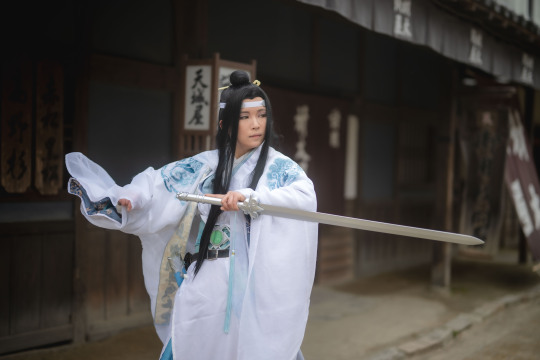
Making Lan Wangji
(AKA My Lan Zhan Cosplay Log)
This went from a historical project to cosplaying all the Hanguang-Jun, Lan Wangji in existence! The main concept is Lan Wangji’s (LWJ) novel/manhua/audio drama design. As the project started pre-pandemic, I didn’t consider the butler or dragon au in the design. That would be too much. There is a dash of videogame in him since there were some details I liked in that model. If the title is “Mo Dao Zu Shi” then I have incorporated Lan Wangji’s description and concept arts into my design.
Lan Wangji as known in The Untamed was generally avoided save for a tiny nod to the show’s Gusu Lan Clan. “Mo Dao Zu Shi” Wangji and “Untamed” Wangji are distinct in my opinion. Neither is superior from the other, just different enough that I need to pick one interpretation to play with. The actors of Untamed, especially Xiao Zhan, really claimed the characters as their own and portrayed them wonderfully. Wang Yibo’s Wangji is his Wangji, I won’t interfere that. If you want to see that interpretation of Lan Wangji, then go watch the show. It already exists.
A few caveats before you dive in:
1) I am not a seamstress or tailor so I don’t know all the proper sewing terminology in English or any other language
2) Also, modern romanization of Chinese confuses the shit out of me, a native speaker, so apologies for any spelling mistakes. The Yale Romanization made so much more sense but then China thought they understood the English alphabet better than native English speakers so here we are. Do as the Romans do, I guess.
3) I am not a historical costumer either so all my info come from conjecture and research
4) I am not a Chinese historian but I like to think I know enough about my history and culture through osmosis and the hell-hole disguised as Chinese school to talk about it
5) I am not trying to make an authentic historical costume, I’m trying to make an anachronistic fantasy costume. Historicity went out the window the minute LWJ and every adult character decided to have their hair down. I did try to make a semi-historically accurate version? Depended on the mood at time of construction.
6) I suck at being Chinese apparently so that will be my safety net if everything fails horribly :P
The Lan Zhan Cosplay Log
Layer 1: Undergarments! 中衣
Layer 2A: Yichang 衣裳
Layer 2B: Ruqun 襦裙
Layer 3: Zhiju 直裾
Layer 4A: Leatherwork
Layer 4B: Jade Bling
Layer 5A: Dachang 大氅
Layer 5B: Bijia 比甲
Layer 0: Hair, Props, “Cheating,” & Overall Stats
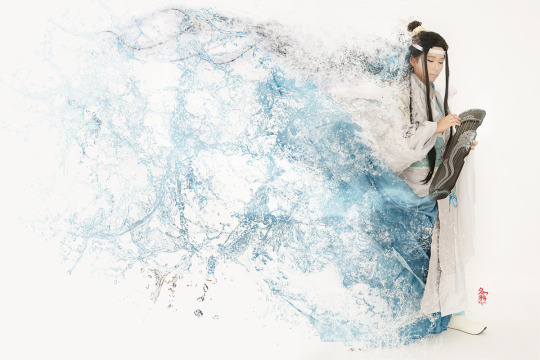
Exhibit: LWJ cosplay in action [1][2]
Citation
Patterning: https://www.bilibili.com/video/BV1Qb411j7z6?spm_id_from=333.905.b_72656c61746564.1
http://www.yeoh.com/index2.php?section=journal&g=691
https://cosplayqna.tumblr.com/image/38971971992
https://torguqin.wordpress.com/hanfu/hanfu-tutorial-list/
Hanfu Resources:
@ziseviolet: https://ziseviolet.tumblr.com/about
@fouryearsofshades: https://fouryearsofshades.tumblr.com/post/179249195707/hello-do-you-happen-to-have-a-master-post-of-all
#my cosplay#yugiricos#yugiri315#cosplaywip#cosplay wip#cosplay#dansou cosplay#historical costuming#hanfu#lwj#lan wangji#lan zhan#mdzs#mo dao zu shi#漢服#魔道祖师#魔道祖師#蓝忘机#蓝湛#男装コスプレ#コスプレ#lwj cosplay log#finally done with writing about this monster project
6 notes
·
View notes
Photo
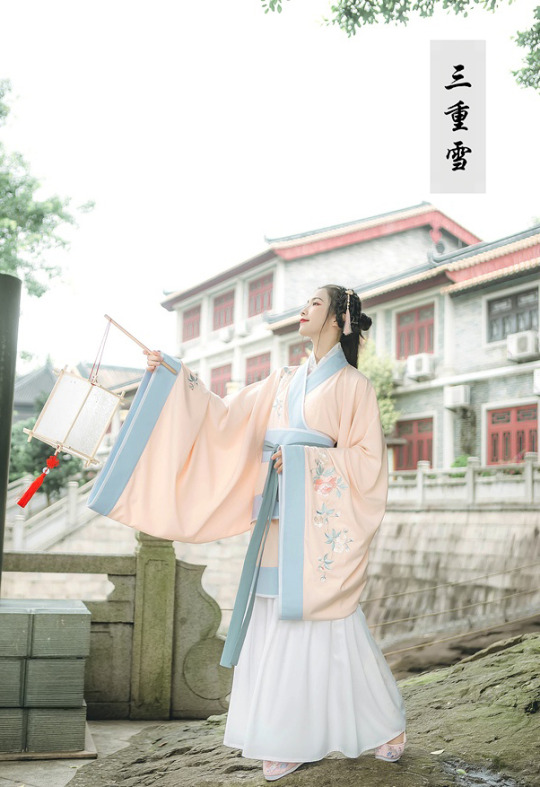


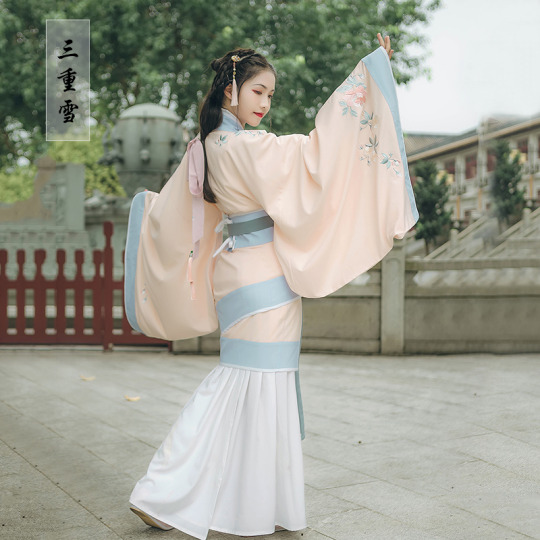
#深衣#shenyi#zhiju#直裾#汉服婚服#汉服运动#汉服#漢服運動#漢服#hanfu#hanfu movement#china#chinese#chinese folk#chinese fashion#chinese culture#Chinese Costume#chinese outfit#chinese attire#woman fashion#East Asia#asia#asian#asian folk costume#Asian fashion#Asian Folk#asian culture#asian costume#asian outfit#asian attire
213 notes
·
View notes
Photo
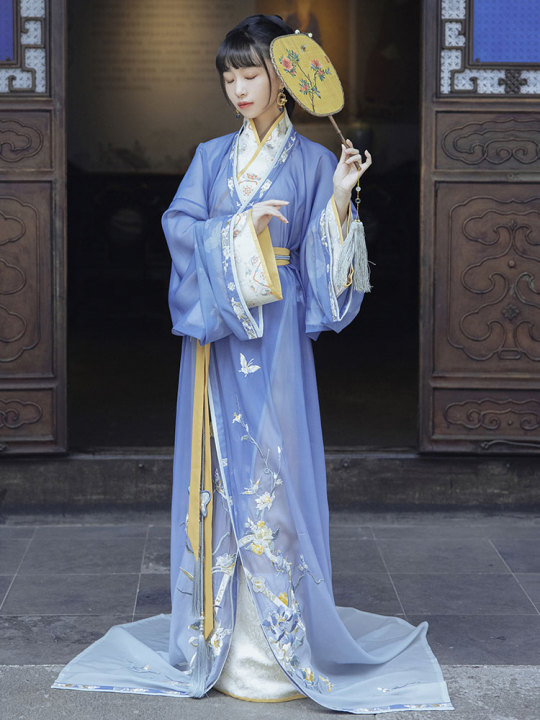



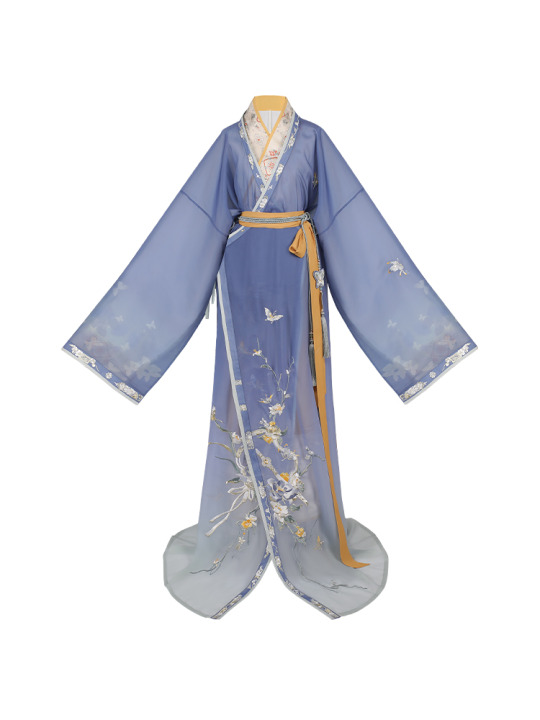
chinese hanfu by 十三余
433 notes
·
View notes
Text
An idiot’s guide to making cdrama period dress - the Wen Ke Xing edition.
Like many people, I was sucked into the cdrama Word of Honor and it has consumed more of my life than I’d like to admit. I’m always big into making character outfits under the pretense of a great Halloween costume, but really, I should come clean that I just like to do some cosplay/historical dress/fun outfits. Thank you pandemic lockdown and lack of traveling; I really got into historical dress youtubers and it shows in my new interest in natural fibers and vintage patterns.
My goal is the make a full replica of the following outfit from the show.

I chose this one for several reasons.
i.) this is one of the simpler outfits that WKX wears. The outer green jacket has a fairly straight cut in front and has unstructured shoulders.
ii.) the blue and red layers and both following a ‘long shirt’ pattern, and again are simple in structure.
iii.) the belt is also a large band with a red cord as the major accent.
iv.) color scheme; I personally prefer his blue/green/purple outfits and I like the pop of red he frequently wears as a part of layer 2, a reference to his role as the ghost valley master.
With this in mind, I did some research using ye olde interwebs. I tried to find resources, but they are rather limited in English. I can find tons of images for patterns in Chinese with an image search, but what I want is a step by step guide for how to sew it together and to know what parts can be modified and what parts have to be kept constant.
There is a website with resources based in Toronto, but I suspect this was written by an engineer based on how text heavy it is and the use of a CAD program.
https://torguqin.wordpress.com/hanfu/hanfu-tutorial-list/
I’ve read it several times over and as someone with sewing experience, I would have preferred more pictures. Maybe this makes more sense to other readers, but I felt pretty meh about it.
I turned to finding a more traditional pattern making guide and purchased this book; Hanfu Pattern Making by TT Duong. It is available as an ebook on Amazon with both metric and English units.

I chose the English units version as I’m currently in the States. Sure, I could have gotten the metric one - I use metric for my job and lived in Canada for 5 years for work meaning I only do temperatures in Celsius but but but. . . . I bought my sewing machine in the States and the seam allowance markers are all in inches. American scientist problems, am I right?
The Hanfu Pattern Making book is fairly easy to understand; the major concepts for making a wide variety of garments and highlights the mix and match abilities of them as well. This was how I determined that the red and blue layers of WKX’s outfit are following the long shirt pattern shown here. I think this corresponds to the Zhiju/直裾 - straight-hem robe as described by @ziseviolet

Most importantly, the book helps you estimate the total yardage of fabric you will need and instructs how to lay the pattern down on the fabric and how to cut it out according to the grain line and selvedge. This is critical for getting the correct draping effect with the fabric and will it allow to fit and flow better when you are wearing it.
With the wider teardrop shaped sleeves, I decided on an extra yard of fabric. I’m still not sure if this will be enough - I may need to make it a little less curved and not quite as wide but I’ll update as necessary.
This requires you to draft your pattern ‘from scratch’ and I can already state that a mock-up will be essential. The guide also has estimates e.g. a curve of 4-6″ at the base so make sure you are consistent with your choices. I am going to give a suggested order of events on how to most efficiently establish your workflow.
Fabric selection:
Although a bit counter-intuitive, I chose to purchase my fabric first. After over thirty minutes of searching for good fabric matches from domestic suppliers ranging from Mood to JoAnn’s to my aunt’s sister’s shop, I realized it would be easier to [gasp] order fabric directly from China even with a variable shipping time. Plus, I could find patterns that are much closer matches to the original than anything here in the States.
I picked a bamboo fabric for the coat in a baby green color ordering 4m which is ~4 yards.

The fabric was in stock and shipped out fairly quickly and cleared customs without issue arriving 20 days faster than expected.
For the blue layer ( Zhiju/直裾 - straight-hem robe?) I went with this fabric with a leaf pattern. I choose it as a color match, not as a pattern match since I couldn’t find any fabrics in dusty blue with blades of grass. I also ordered 4m, again ~4 yards.

Unfortunately, this was still in production when I ordered it and I’m currently waiting for it to ship out. The seller has updated me on the status and I’m hoping it ships out soon. Update - my blue fabric arrived safely in the States, 1 day after the original predicted delivery date. Nice! I would highly recommend this fabric seller; excellent customer service.
The red layer ( Zhiju/直裾 - straight-hem robe?) I decided to save some money and purchase a cotton fabric locally at JoAnn’s. I wanted cotton since it breathes and something that looked close-ish but under $10/yard. I chose this cotton calico, which normally would be used for quilting, but the calicos have abstract patterns that mimic the patterns woven into silk. I bought 4 yards.
Update - I had to buy another 1.5 yards b/c I couldn’t quite fit my pieces; the fabric isn’t very wide and my sleeves were going to end up too short. Double check the width of your fabric. Unlike the imported fabrics this fabric was pretty short for width compared to other fabrics.

I may change my mind in the future and upgrade it also to silk but for right now I’m curious to see if it works out fine as it is only the second layer.
For the white Zhong Yi/中衣 (middle clothes) first layer, I just got basic cotton twill, and purchased 3 yards. I’m not including a picture b/c it is just basic white cotton.
Lastly, I bought 4 yards of white cotton muslin at $6/yard to make a mock-up. Also no fun picture of crappy fabric for you.
Make sure to wash and iron all of your fabric before using! I washed the cotton on cold with an unscented detergent air-dried it and then ironed out major wrinkles.
Drafting the pattern:
Following the directions in Hanfu Pattern Making, I took a bunch of measurements of myself. This would likely be slightly more accurate if someone else did this for me, but I live alone and my cat isn’t capable of assisting me. The fact that the book tells you exactly what to measure and then how to apply it, is vastly easier than the link above (sorry likely Canadian engineer).
The measurements allow you to plug and play to generate your draft pattern. This was my first sketch, which is rough and not drawn to scale.
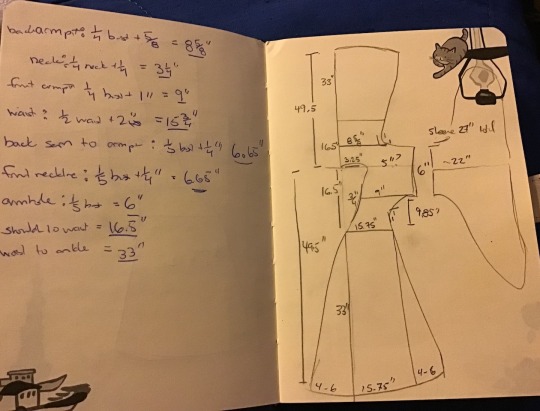
On the left you can see the measurement for various parts. Above was my first attempt for layer 2. For the flare at the base, I chose 4″ and followed the suggested 3/4″ curve.
back armpit measurement is equal to: 1/4 bust + 5/8″
my bust is 32″, so 1/4 is 8″ and I add 5/8″ to that = 8 and 5/8″
waist is equal to: 1/2 waist + 2″
my waist is 27.5″, so 13.75″ (13 and 3/4″) + 2″ = 15.75″ (15 and 3/4″)
Therefore, once you are done calculating the various measurements you can add them onto a rough sketch of the shape of the pattern.
I choose to start with what the book refers to as layer 2 for my initial measurements. This is because I wanted to do the mock-up to correspond to the red second layer. I don’t think it matters which layer you decide to start from since you will either be adding or subtracting from a layer to change to the one above or below it.
With my Hokkaido cat notebook in hand, filled with my notes and numbers, I drafted the pattern. For drafting paper, I went to Target and bought gift wrapping paper as it has a grid pattern on the backside. This pattern is massive, even with my kitchen table, I still couldn’t fit all of it on my cardboard cutting guide! You can’t clearly see the grid on the ‘wrong’ side of the wrapping paper, but it is there. Since the wrapping paper wanted to curl, books were used on the corners and I didn’t need that many extra tools.

For drafting, I used a 2B pencil, the 2″ wide by 18″ long ruler with holes in the middle (from JoAnn’s) and the 12″ curve ruler. I also had a measuring tape to roughly mark of distance. I went over the pencil with a ballpoint pen once I decided on the lines and shape.
The curve of the neckline was the hardest part. I made an X in the corner of the neck line and an X at the waistline point. I then connected this with a straight line and at the halfway point took the line in by 1/2″ (towards the side of the body). The suggestion of the book is 3/4″, but I decided to be a little more conservative. I then gently made the slight curve by hand so that the most curved point was by 1/2″.
The armpit/shoulder is the next most difficult part. My sketch above isn’t quite correct, the 6″ should be doubled, 6″ for the front and 6″ for the back based on my measurements. You need to make sure that the armpit curves are in line with each other! I had the back one off and I had to erase it and redraw it.
I started with the initial curve of a 1″ armpit as suggested in the book. It says the curve can between 1/2″-2″. Note that the book is designed for a very small size range, from about 5′ to 5′5″ (152.4-165 cm) and I am 5′3″ (160 cm).
To make the curve, I used the curved ruler to trace a nice smooth line. Just make sure you use the same part of the ruler e.g. 1″ to 3″ or 9″ to 12″ etc. I went with the curve that looked the best.
This pattern doesn’t include seam allowance - you will have to add that on when cutting. To be most accurate, trace the pattern onto your fabric. I like to use the removable fabric markers like these:

You can then use the other color to mark out dots along the fabric for seam allowance, like 5/8″. If you can’t use fabric markers there are also removable mechanical pencils that come in yellow, magenta or you can be old school and use chalk.
I transferred the pattern to the cheap cotton muslin fabric and cut it out. There aren’t many seams to sew and I ignored the sleeves since I wanted to determine if the pattern fit me well. I placed the right sides together and first sewn together the back seam. After that I did the armpit/side seams, leaving the armpit unfinished on the end and check the fit. Already you can see that the neckline isn’t laying flat and the armpits are super tight.

I just grabbed a long scarf to tie it down and adjust the fit at the waist.

Leaning forward you can see the neckline is even more of a mess and the armpits are far to tight even though I am wearing a fitted t-shirt underneath (as this is layer two).
I went back to the drawing board to adjust the pattern. I kept my original pattern and added more paper to the armpit and neckline area to draft a new pattern and cut it out instead of a completely new draft since the waist down was totally fine, falling around my ankles.
This time I made a 2″ curve for the armpit, added more length to the armpit as well and only sewed the top with some scrap blue fabric. As you can see here, it was a more optimal armpit fit.

I also shifted the neckline curve to reduce it to 1/4″ instead of the 1/2″ from the first mock up. This was an excellent decision as it fit in the chest area much better. This is my sketch to reshape the neckline.

This is how it looked on me. Excellent!
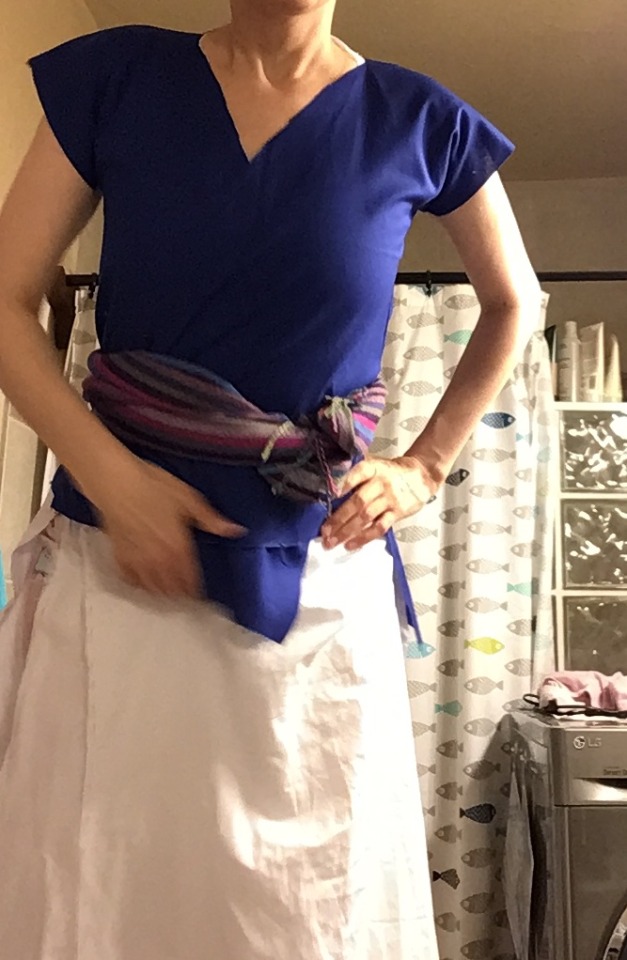
The neck still looks wide because I haven’t added the neck placket but the fabric lays much more naturally. My conclusion to date is that if you don’t have a very large bust size, err on the side of making the neckline less curved.
What I also concluded from this mock up is that my measurements for layer 2 are more likely my layer 1 measurements since they were quite form fitting on top.
The next step (backwards compared to the suggested order in the book) was to add sleeves. I guessed what shape would work best and my first draft was terrible as shown here.

The bottom was too square and I was trying to figure it out based on this scene from the drama. I chose this model for the sleeve since you can tell that the white layer in WKX’s outfits has a relatively wide sleeve.
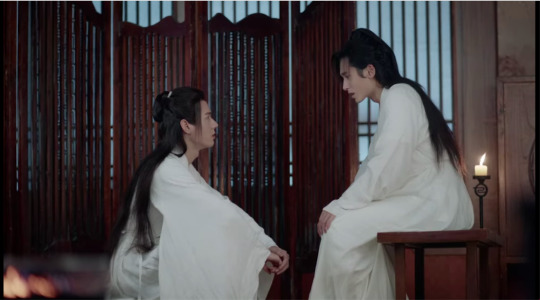
The only part that I used the pattern for reference was how to attach it to the armpit at the shoulder. The overall sleeve shape was just what I thought looked nice. Keep in mind that the shoulder seam sits fairly low on the shoulder compared to a modern garment. The seam line is a few inches down from the shoulder and you can see that the garment will naturally pucker in front of the armpit. In his several days of drunken sulking, you can see the seam line is even with the back of the chair.

The weight of the sleeve itself helps to hold the shoulder structure and it doesn’t pop up as you see on my second mock-up with the blue fabric.
I drastically reduced the size of the sleeve curve and made a pattern based on something that seemed alright. With all of this mock-up work done, I decided to turn to making the first layer, the Zhong Yi/中衣 which I have summarized as a separate post.
#stickey#wen kexing#word of honor#sha he ling#WOH#shl#hanfu#cdrama#cdrama dress#pattern drafting#sewing#cosplay#sticky
243 notes
·
View notes
Photo



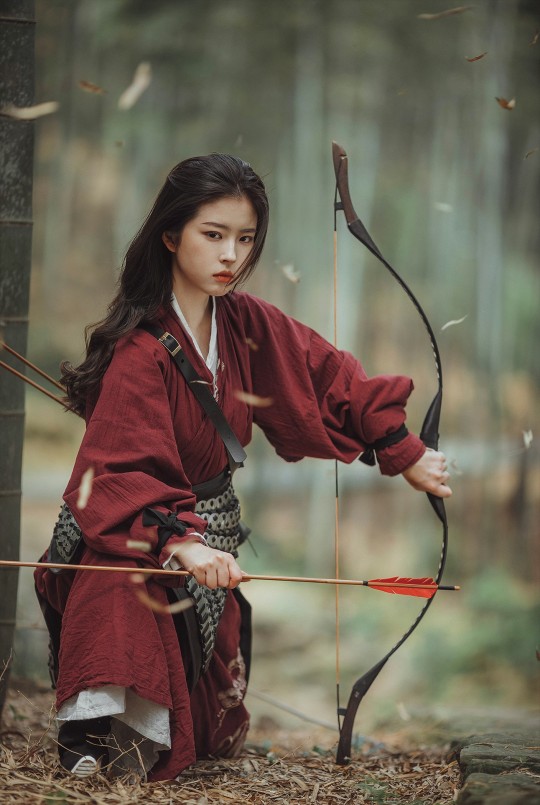

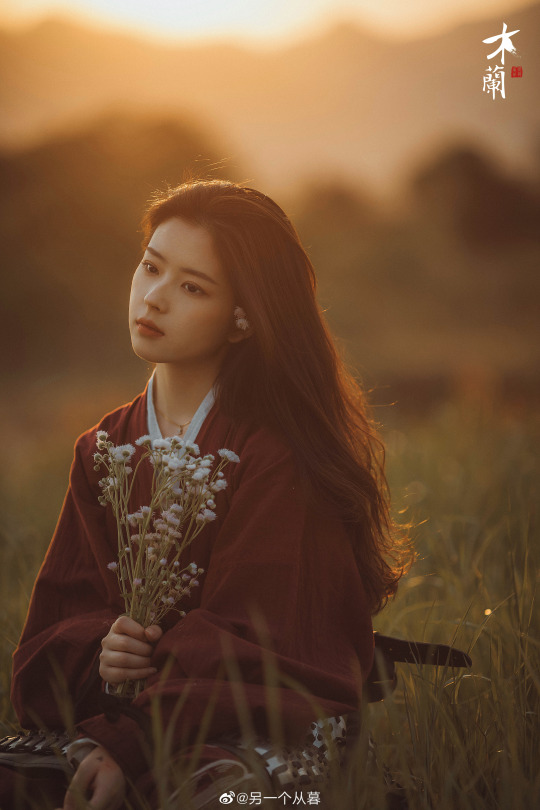

She traveled ten thousand miles to do battle,
and traversed mountain passes as though flying;
the night air moved the watchman’s rattle;
the cold light glinted on her armor. - The Ballad of Mulan
Mulan-inspired hanfu photoshoot by 另一个从暮. Traditional Chinese hanfu - type: Zhiju/直裾 (straight-hem robe) from 一七令汉服雅斋. Armor from 捧日虎骑. Model: 安大妮one.
#mulan#hanfu#zhiju#armor#archery#swords#poetry#一七令汉服雅斋#另一个从暮#捧日虎骑#安大妮one#>1000#chinese fashion#china
2K notes
·
View notes
Photo
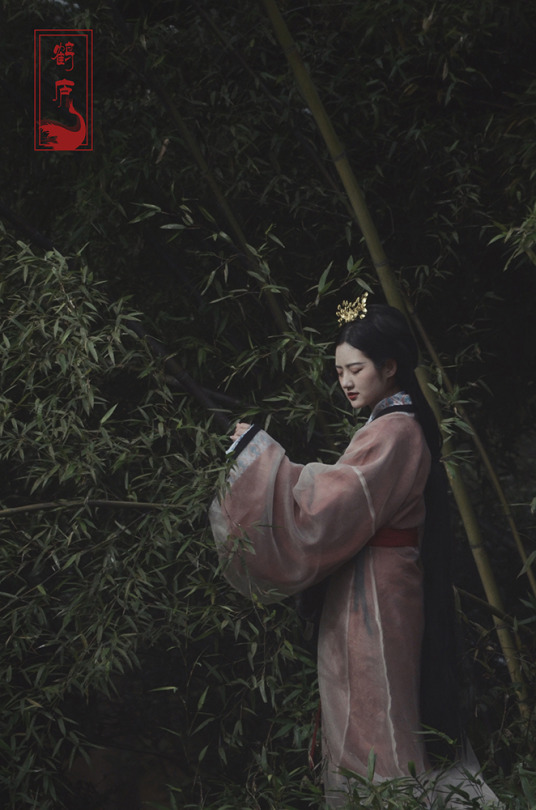

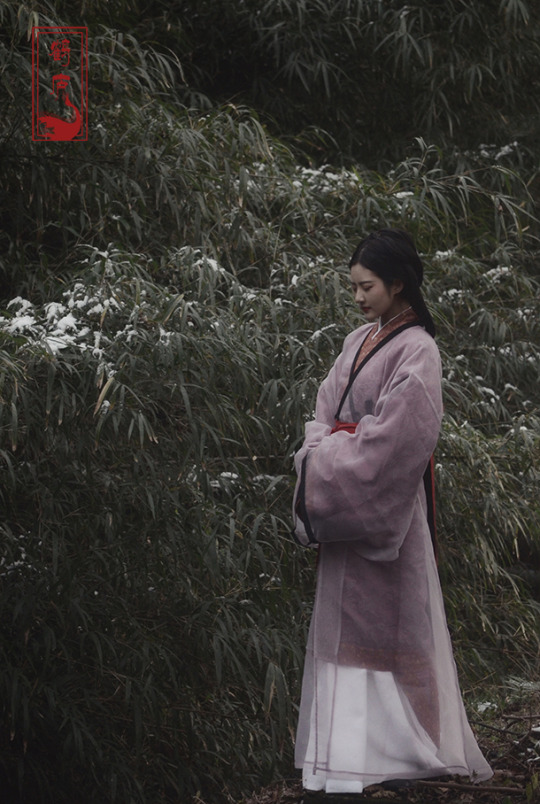






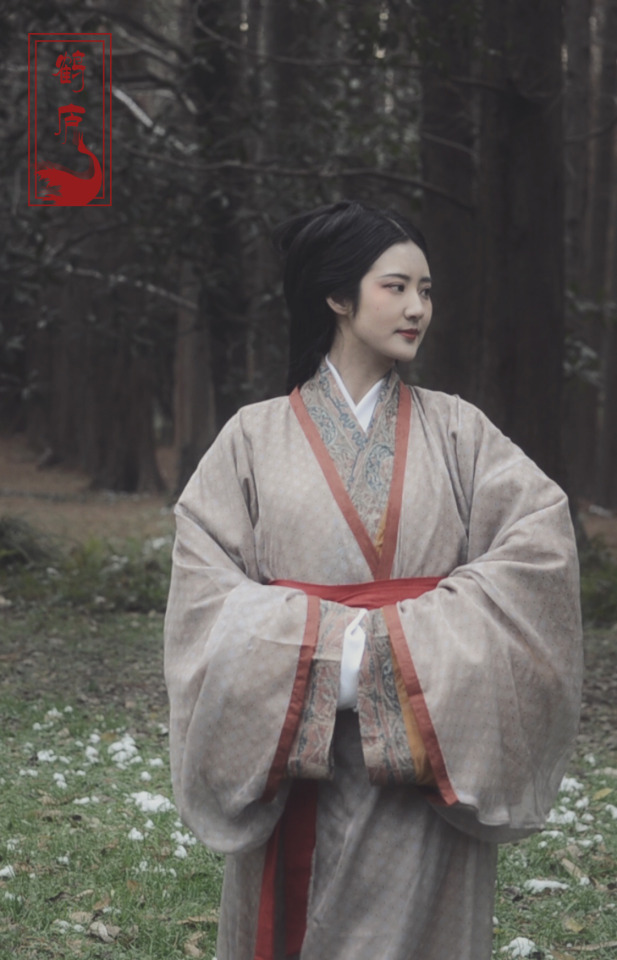
直裾袍+燕尾曲+素纱禅衣 by 鹤庐汉服
zhiju + quju + shanyi
129 notes
·
View notes
Photo


⸸ 汉服直裾 / ZhiJu - mtsims-cakestore ⸸ Resurrectd Link ⸸
清霜童子(QingshuangTongzi)
1 衣服 / 1 Clothes
28 notes
·
View notes
Text
WeiWuxian Yiling Patriach Costume Worklog
Part 1 Costume Overview
This costume was made together with Jushiiro @nekoomata who cosplayed WeiWuxian. You can check out his Instagram to see the full cosplay and his other works. (Instagram :https://www.instagram.com/jushiiro/ )
First of all let me clarify, that this costume was not meant to be historically accurate neither in terms of construction nor the fabrics that were used. The names listed below for the garments are used for reference only since my knowledge of Hanfu clothing is still quite limited.
(If you want to know more about hanfu I recommend checking out @ziseviolet tumblr blog, it is one of the best resources for anything hanfu related and the author is also very willing to help and respond to questions
WeiWuxian’s Yiling Patriarch Costume consists of parts:
A grey coat ( 大氅dachang) with red decorative flames on the sleeves.
An inner garment called 直裾zhiju which is a type of male hanfu that resembles a kimono.
A black sash (腰带yaodai) which is tied with a red belt (系带xidai).

#wei wuxian#wei wuxian cosplay#yiling patriarch#yiling laozu#hanfu#modaozushicosplay#tutorial#sewingtutorial#Cosplay Tutorial#sewing
190 notes
·
View notes
Text
5 Types of Traditional Chinese Clothing & Dress
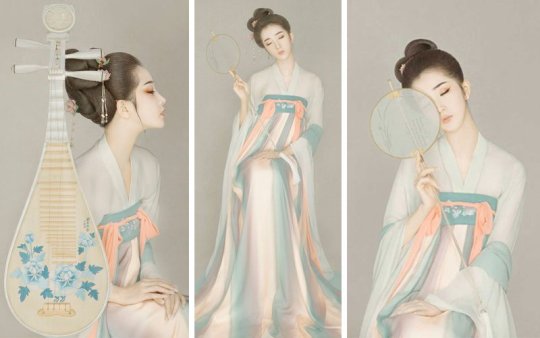
The story of clothing is one of the fascinating developments in human history. Each country in the world has its unique traditional costumes, which can identify specific histories and cultures and enable people to distinguish different citizens.
China is a country with a long history, and many ethnic minorities have their own national culture. The mutual influence of these different cultures has created rich textures and fabrics in history, which has brought about significant changes and glories in Chinese clothing.
Chinese traditional costumes were formed and developed under the interaction between the outside world and China's own dynastic traditions.
Each Dynasty had different boundaries, social values, social norms, etc. As a result, many aesthetic standards were based on the circumstances of a particular dynasty (social, geographical, economic, political). This is the main reason why there are so many styles of traditional Chinese dress.
5 kinds of traditional Chinese clothing
Before we explore the world of traditional Chinese clothing, it is necessary to learn the five most classic categories. They are Hanfu, Cheongsam, Tang Zhuang, Zhongshan Zhuang, and ethnic customs.
Each category has its own production process, and there are significant differences between different types or when the same model is compared at different times.
This article will briefly introduce each category. By reading the following, we can build the basic framework of traditional Chinese clothing.
The name of Hanfu comes from Chinese, which means "clothes of the Han people" and includes all types and styles of traditional clothing worn by the Han people.
The common ancestor of the Han people in Huaxia. Huaxia is the name of the original alliance of agricultural tribes in the Yellow River valley. The term Huaxia represents a corporate alliance of neolithic farming tribes, Hua and Xia, who lived in the central plains in the middle and lower reaches of the Yellow River in northern China.
Hanfu, like its definition, was born at the beginning of the development history of the Han people. Therefore, it has the most extended history among all the traditional Chinese clothing.
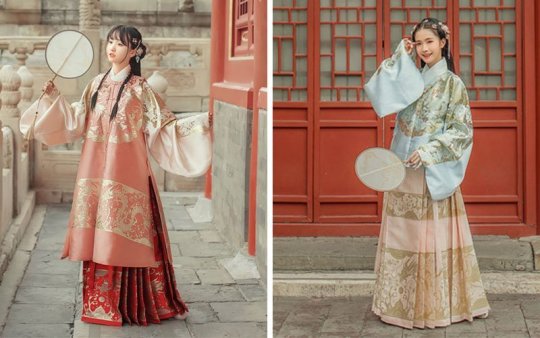
1, Historical Hanfu
Hanfu has a history of more than 3,000 years. From its history, Hanfu has been inextricably linked with silk, which is said to have been discovered by the Yellow Emperor's wife, Leizu.
From the Yellow Emperor (2969-2598 BC) to the Ming dynasty (1368-1644 BC), Hanfu dominated China's fashion world.
Each Dynasty had its own style and aesthetics. Such as the pre-qin period "Shenyi"; your clothes from the Qin and Han dynasties; Tiaowenjiansequn of the Wei dynasty; Bambi in Sui and Tang dynasties.
Some clothes were trendy in different dynasties, some were just a flash in the pan. In both cases, all Hanfu evolved and influenced each other to some extent.
Although there are many styles of Hanfu, each can be assembled with a suit of clothes.
Yi (衣) any open cross-collar garment, and worn by both sexes
Pao (袍) any closed full-body garment, worn only by men
Ru (襦) open cross-collar shirt
Shan (衫) open cross-collar shirt or jacket that is worn over the Yi
Qun (裙) or Chang (裳) skirt for women and men
Ku (裈) trousers or pants
Follows are the introduction of some Hanfu styles.
Zhongyi (中衣) or Zhongdan (中单) inner garments, mostly white cotton or silk
Shanqun (衫裙) a short coat with a long skirt
Ruqun (襦裙) a top clothing with a separate lower garment or skirt
Kuzhe (裤褶) a short coat with trousers
Zhiduo/Zhishen (直裰/直身) a Ming Dynasty style robe, similar to a Shenyi but with vents at the side and “stitched sleeves” (eg, the sleeve cuff is closed save a small opening for the hand to go through)
Daopao/Fusha (道袍/彿裟) Taoist/Buddhist priests’ full-dress ceremonial robes
Xuanduan (玄端) a very formal dark robe; equivalent to the Western white tie
Shenyi (深衣) a long whole-body garment
Quju (曲裾) diagonal body wrapping
Zhiju (直裾) straight lapels
Yuanlingshan (圆领衫), Lanshan (襕衫) or Panlingpao (盘领袍): closed, round-collared robe; mostly used for official or academical dress
reference wiki

2. Cheongsam or Qipao
The cheongsam is a kind of traditional dress, its history can be traced back to the 17th century. It is Manchu tights with distinctive Chinese characteristics. In the 1920s and 1930s, it was known as the "Mandas dress" and became popular among upper-class women in Shanghai.
The history of the cheongsam
In the qing dynasty, the Manchu, not the Han, ruled China. The rulers used an administrative division called the eight flags system. At first, only Manchu families were organized in the order, but above them were Mongols and Han Chinese.
The Manchus and anyone living under the eight banners wore clothes different from those of ordinary people. The garment is made up of robes similar to those of men and women and is called a robe.
For a time, under the laws of the Dynasty after 1636, and all Han Chinese had to wear Manchu men's hair, line up, and wear Manchu robes instead of traditional Han dress, or else they were sentenced to death.
In the 19th century, however, it was common for women to wear cheongsam voluntarily on both formal and casual occasions.
Today, the cheongsam is known for its exotic but straightforward lines and has inspired many foreign film adaptations. It is prevalent because it suits the figure of Chinese women very well; the line is simple, looks very elegant. Suitable for young and old people to wear throughout the year.
Modern women do not wear cheongsam as their daily wear. It is now only worn for formal occasions, such as weddings, parties, and beauty pageants. It is also used as a uniform by some Chinese restaurants, hotels, and airlines.
In China, cheongsam is usually a red wedding dress. Cheongsam is generally embroidered with exquisite gold and silver patterns. Brides in southern China wear a cheongsam or a two-piece makeover with elaborate golden dragons and phoenixes. Dragon and phoenix are the traditional wedding patterns favored by Chinese brides today.
3. Tang Suit
Tang suit, also translated as Tangzhuang, is often referred to as a modern Chinese jacket rather than a Tang dynasty.
Origin of name
Although the Tang suit is not the costume of the Tang dynasty, it has a particular relationship with the Tang dynasty. The Tang dynasty was one of the most prosperous periods in Chinese history. Therefore, people often use "Tang" to refer to traditional Chinese culture. For example, Chinatowns in the US or UK are also known as "Chinatown (Tang people street)".
Tang suit, as the name of Chinatown, represents a kind of dress with deep Chinese traditional culture.
Tang Suit History
The history of the Tang suit can be traced back to the early 20th century (late Qing dynasty). It is a combination of Manchu jacket elements and western jacket elements.
The Chinese government released a new unified system in 1929. Under this new system, the Tang suit became a kind of formal dress for Chinese men. Also around 1929, the media all over the world start to extensive reports and the introduction to the Tang suit. People all over the world began to think of the Tang suit as one of the most typical traditional Chinese clothes.
In recent years, with the diversification of Tang suit styles and production techniques, the Tang suit is becoming more and more popular not only In China but also in the world.
Tang suit appeared in many international events. In 2001, the Asia-pacific economic cooperation (APEC) meeting, all the leaders wore Tang suit, blue, bright red, and with China's national flower peony circular design. Besides, the Tang suit also appeared in the 2008 Olympic Games and some of the World Trade Organization meeting.
Also, Tang suit elements have appeared in many famous Kungfu films and TV series. Thanks to the joint efforts of designers and the cultural industry, the influence of the Tang suit has spread further and further.
4. Zhongshan Suit
The modern Chinese tunic suit is a style of male attire known initially in China as the Zhongshan suit (after Sun Yet-Sen, also called Sun Zhongshan), and later as the Mao suit (after Mao Zedong).
Sun yat-sen introduced the style as a form of national costume in China shortly after the founding of the Republic of China, despite its obvious political and later governmental implications. He designed the suit based on the uniforms of Japanese military cadets.
The suit is also said to have cultural connotations, with four pockets representing the four great virtues of Chinese culture: propriety, righteousness, honesty and shame, and five buttons representing five branches of the Chinese government.
History of the Zhongshan Suit
When the Republic of China was founded in 1912, China's style of dress was based on Manchu clothing (cheongsam and Changshan), which the Qing dynasty imposed as a form of social control.
The majority of Han Chinese revolutionaries who overthrew the Qing were fueled by the failure of the Qing to defend China and a lack of scientific advancement compared to the West. Even before the founding of the Republic, older forms of Chinese dress were becoming unpopular among the elite. They led to the development of Chinese dress which combined the changshan and the Western hat to form a new dress. The Zhongshan suit is a similar development that combined Western and Eastern fashions.
Most of the Han revolutionaries overthrew the Qing government because it failed to defend China and lack of scientific progress compared to the West. Even before the founding of the republic, the old Chinese dress had become unpopular among the elite, which led to the development of Chinese dress, which combined the Changshan with the western hat to form a new dress. Zhongshan suit is a similar development that combines western and eastern fashions.
The Zhongshan suit remains the standard dress for the first and second generation of leaders of the People's Republic of China, including Deng Xiaoping. In the 1990s, as more and more Chinese politicians began to wear traditional western-style suits and ties, leaders of general secretary Jiang Zemin's generation began to wear them less and less frequently.
Jiang Zemin, Hu Jintao, and Xi Jinping only wear Zhongshan suits for special occasions, such as essential banquets or the 2019 celebration of the 70th anniversary of the founding of the People's Republic of China.
Hu Jintao even showed up to a black-tie state dinner in the United States wearing a business suit, attracting some criticism for being underdressed at a formal occasion. In the Xi Jinping administration, however, the Zhongshan suit made a comeback as a diplomatic uniform and evening dress.
5. Ethnic Minorities
Japan, Korea, France, Greece, and other countries are nation-states. China has been a multi-ethnic country since ancient times.
China's ethnic minorities are the non-Han population of China. China officially recognizes 55 ethnic minorities except the Han. As of 2010, the officially recognized ethnic minority population accounted for 8.49% of the mainland's population.
The degree of difference among ethnic groups is inconsistent. Many ethnic groups have been described as having unique characteristics with other ethnic minorities and the Han. Still, some are very similar to the Han majority. The vast majority of Hui are indistinguishable from Han Chinese except that they are Muslim, and most Manchus are considered primarily integrated into the dominant Han Chinese society.
There are 55 ethnic minorities, including Mongolian, Hui, Tibetan, Uygur, Miao, Yi, Zhuang, Dai and etc.
In terms of minority costumes, there are significant differences among ethnic groups due to the influence of geography, culture, history, and other factors.
Features of the ethnic minority clothing
The characteristic feature of minority clothing is colorful, exquisite, and distinctive. Every aspect of their clothing, such as raw materials, textile technology, fashion, and decoration, retains distinct national and local characteristics.
The Hezhen people lived mainly by fishing and used to make fishskin clothes. The Oroque and Ewenki, hunting nationalities, used roe skin and animal tendon to make their clothes
The Mongolians, Tibetans, Kazakstan, Khalkhases, Yugurs, etc., who are mainly engaged in stockbreeding, make their apparel mostly from animal skin and hair. Moreover, the agricultural minorities usually use locally produced cotton or twine as raw material for weaving and clothing
The technology of weaving, tanning, and felting has a long history in ethnic minorities. For example, the kapok cloth of Li nationality, the wool fabric of Tibetan nationality, the Adelie silk of Uygur nationality, the furs of Oroqen, and so on have been enjoying the world reputation.
The costume designs and forms of China's ethnic minorities are varied. Generally speaking, there are two categories: long dresses and short dresses. People usually wear hats and boots with long skirts and headgear and shoes with short clothes.
The robe comes in many forms: the Mongolian, Manchu, and Tu people wear a high-necked forward style. Tibetan wear no collar inclined forward.
The tilted-front style worn by the Uygur and other ethnic minorities. And so on. As for short clothes, there are two kinds: trousers and skirts.
The costumes of ethnic minorities not only vary significantly according to different nationalities but also have different branches and different regions within the same nationality. Differences can be seen from province to province, from county to county, and even from village to village. Clothing is the most visible symbol of a nation. Historically, many countries were named after their clothing.
7 key changes to traditional Chinese clothing
5 categories of traditional Chinese clothing are introduced. In general, each of these can be identified by 7 key changes.
1, In design, traditional Chinese clothing is usually straight cut, loose shape. Also, the overall harmony of the dress is also emphasized.
2, Embroidery is a folk art with a long tradition. It occupies an essential position in the history of Chinese arts and crafts. In its long development process, it is inseparable from sericulture, silk reeling, and weaving. The production of silk threads and fabrics gave rise to the Chinese art of embroidery, which became very complicated and delicate.
3, In daily life, people usually wear light-colored clothes. Red, bright yellow and purple were typically reserved for emperors and royalty. Most of the crowd wore red at the wedding. Besides, white dresses are usually worn at funerals. For example, for women, only the wives of queens or officials can wear real red, which is not allowed for concubines.
4, In ancient feudal society, people's rank and social status were easily reflected in their daily clothes, especially for ordinary people and the upper class. Among the upper ruling classes, only the emperors were given the symbol of the yellow and dragon in traditional Chinese costume as the only affirmation of their power. As for ministers, generals, councilors, and their wives, their uniforms also had strict rules on how many lions or cranes were to be embroidered.
5, In terms of gender, women's clothing is more diverse than men's clothing. Compared with men's wear, women's wear has more decorations, objects, and styles.
6, In the beginning, the ancient Chinese just covered their bodies with leaves. With the development of agriculture, more clothing materials appeared. In later years, linen, cotton, and silk were the primary materials. During the Ming dynasty (1368-1644), according to the government's policies of heavy farming and restricting commerce, merchants were forbidden to wear silk clothes, even if they were rich.
7, Almost every Dynasty in history had its own unique costumes, some of which were genuinely exquisite.
Nowadays, more and more fashion designers are committed to improving the traditional fashion design. As wearers, we are not only consumers but also co-manufacturers. Especially in today's market, people are free to choose any style of clothing. Our likes and dislikes determine the course of costume design.
This article only gives a very brief introduction to traditional Chinese clothing. Each of these five categories can be further divided into more subcategories. This is an extensive map, and we've only seen a small part of it.
3 notes
·
View notes
Text
LWJ Cosplay Log
Layer 3: Zhiju 直裾

The final piece of the Chinese 3-piece suit. It is the basic wrap-around robe you see when you look up generic hanfu. I added forward slits because…the official art said so. Gotta show some leg (and the ruqun I painstakingly pleated!)~ The piece is secured with frog clasps and the lapels I made from scratch, it’s like making giant bias tape.
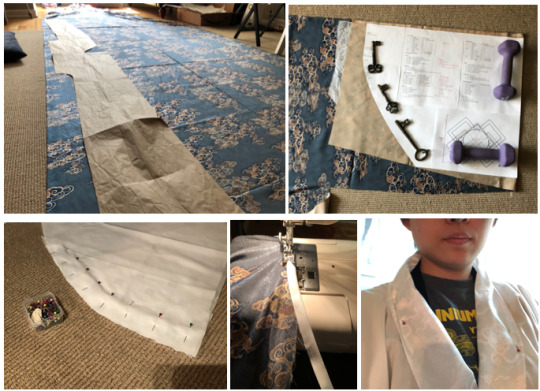
But what is truly noteworthy about my zhiju is the inside because of course I dedicate too much effort on the inside. There are 3 pockets each large enough to hold a smart phone. In traditional hanfu your sleeves and lapel are your pockets but I installed hidden pockets for extra security and to pretend I have pocket dimension sleeves like they do in cultivation novels. The zhiju is also lined with beautiful blue and copper shenyun silk! If you are lucky, I may flash you with some “雲雨” (clouds & rain is an euphemism, look it up) XD
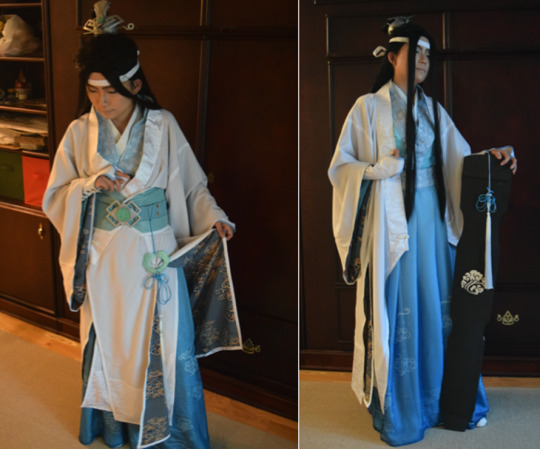
Not to mention the zhiju is actually quite versatile. I can wear it casually as a sort of dachang if I really want to.
youtube
Below is how the zhiju look, worn as intended.

Assistant Photographer/Videographer: Dr. Tog
#yugiri315#yugiricos#yugiricosplay#my cosplay#dansou cosplay#cosplay wip#hanfu#mdzs#mdzs cosplay#mo dao zu shi#lwj#lan zhan#lan wangji#lwj cosplay#漢服#魔道祖师#魔道祖師#蓝湛#蓝忘机#lwj cosplay log#lwj cosplay diary#cosplay log#cosplay diary
18 notes
·
View notes
Photo


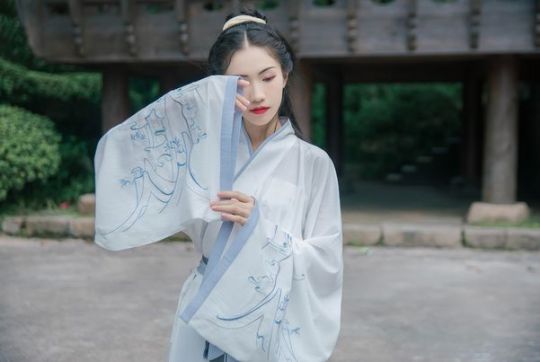



#直裾#zhiju#shenyi#深衣#hanfu#hanfu movement#汉服运动#汉服#漢服運動#漢服#china#chinese#chinese folk#chinese fashion#Chinese Costume#chinese culture#chinese outfit#chinese attire#woman fashion#man fashion#East Asia#asia#asian#asian folk costume#Asian fashion#Asian Folk#asian culture#asian costume#asian outfit#asian attire
257 notes
·
View notes
Photo


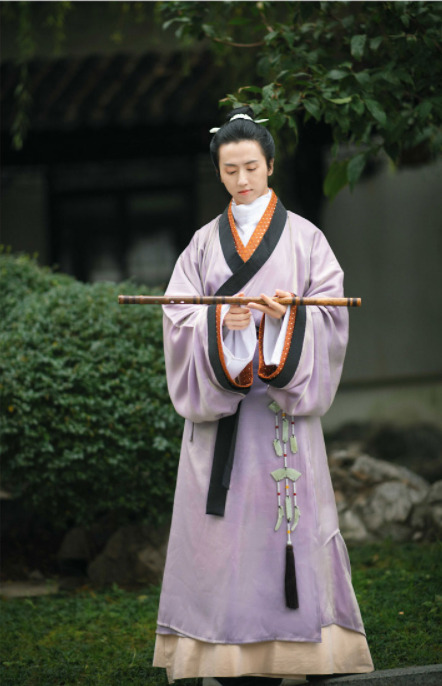





曲领中衣 + 直裾袍 + 交领外衫 by 怀谷居汉服
A quling undershirt plus zhiju robe based on artefacts from Mawangdui tombs.
#hanfu#zhiju#quling#taobao#men's hanfu#怀谷居汉服#men wear#xiao#dizi#chinese musical instrument#jinbu#qin
88 notes
·
View notes
Text
The second layer of Wen KeXing’s outfit; the red zhiju (直裾) layer part 2.
Work got super busy for me, and it is only going to become busier in the next few weeks. Please be patient as I continue on this sewing adventure. I had left off with a mainly finished garment. The only part which I have kept incomplete is the bottom hem on the skirt portion. I don’t want to mess with this until I have the other layers complete and I can then put all of them on at once and then determine the final hemline.
I also procrastinated on deciding how to do the ties for this garment. Since this is me making an outfit from a TV show, I don’t have to be exact for every detail. Wanting to have as little bulk as possible, I decided on using hooks and eyes. I put on the garment, marked out points where the cross-over bits matched up with one of the fabric mechanical pencils and proceeded to ignore it for a few days.
This is because I hate hand sewing with a passion and I hate sewing on hooks and eyes.
After forcing myself, I finally attached them as shown in the following two images.


These show the pairs that don’t overlap. Instead, they are the set of opposite hooks and eyes on the left and right side of the garment.
Hemming the sleeves was straightforward and also boring, but more relaxing than the hooks and eyes. To really get the sleeves into a more appropriate shape, I used the iron first on the inside to smoosh things down, and then laid the sleeve down flat and helped to structure the curve.
Here is a not super photogenic picture of it. I was too lazy to take stuff off of my cutting board, so the right sleeve looks all wrinkly. Please focus on the left sleeve, nicely laying on the cardboard.
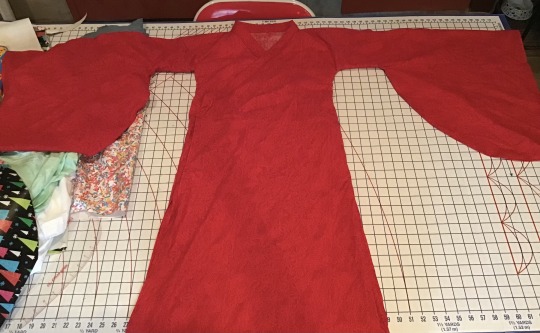
But with that, I’m pretty much done and ready to move onto the next layer!
18 notes
·
View notes
Photo






直裾袍 by 怀谷居汉服
Han-style zhiju
91 notes
·
View notes
Note
Hi! I see in your posts that there are names for the different types of hanfu...but i cannot tell the difference...would you be able to make a post on what the different types of hanfu are? If its too complicated thats ok!
Hi, thanks for the question! I covered the basic types of men’s hanfu here and here, so in this post I’ll describe the basic types of women’s hanfu. Resources on identifying different types of hanfu can be found in my reference tag.
- Ruqun/襦裙 - the most basic type of hanfu consisting of a top and a wrap-around skirt. The top is called “ru/襦” and the skirt is called “qun/ 裙”, hence “ruqun”. Sleeves can be narrow or wide. Generally speaking, people divide ruqun into two types based on the height of the skirt: “Qiyao Ruqun/ 齐腰襦裙” (waist-high ruqun) and “Qixiong Ruqun/ 齐胸襦裙” (chest-high ruqun).
“Qiyao Ruqun” is the kind of ruqun in which the waistband is on the waist. Both men and women can wear it. For women, the top’s collar can be parallel (left), crossed (middle), or u-shaped (right). Men’s ruqun are cross-collared only.

“Qixiong Ruqun”, on the other hand, has its waistband above the chest. The top’s collar can be parallel (left) or crossed (right). It’s only worn by women.

As seen in the photos above, ruqun is often accessorized with a long scarf called Pibo/披帛. Originally used to protect against wind and cold air, pibo gradually became an important feature of hanfu.
- Aoqun/袄裙 - a type of ruqun that became fashionable during the Ming Dynasty. It consists of a double-layered top called “ao/袄“ and a waist-high skirt (”qun”), hence “aoqun”. Unlike the “standard” ruqun that has the top tucked inside the skirt, the aoqun’s top is worn untucked, above the skirt. There are two types of “ao” - “short ao” and “long ao”. The “short ao” (left, right) reaches the waist, while the “long ao” (middle) covers the knees. Ao collars can be crossed (left, middle), upright (right), or square (not shown). Only worn by women.

- Unlike ruqun and aoqun which are made of separate top and bottom pieces, the Shenyi/深衣 style of hanfu consists of one-piece robes that wrap around the body once or several times. Quju/曲裾 (curved-hem robe) and Zhiju/直裾(straight-hem robe) are two types of shenyi. The quju (left, middle) is a robe in which the bottom hem of the left lapel spirals its way up to the waist of the wearer. Modern quju can come in a shortened version (middle) that reveals the skirt worn underneath. In contrast to the quju, the bottom hem of the zhiju (right) circles around levelly, creating a straight line. Quju and Zhiju are worn by both men and women.

- Beizi/褙子 - a parallel-collar “jacket” with side slits beginning at the armpit or at the waist. It can be secured at the front either with ties or a metal button. Extremely versatile, it can be long or short, have narrow or wide sleeves, and is worn by both men and women. During the Song Dynasty, it was popular to wear narrow-sleeved beizi over a chest undergarment and skirt/pants (middle). Another name for Ming Dynasty-style beizi is Pifeng/披风 (right). Pifeng collars can also be upright (not shown).

- Banbi/半臂 - a half-sleeve jacket worn by both men and women. It comes in various lengths and is usually worn over ruqun. Its collar can be parallel (left), crossed (middle), or u-shaped (right). When paired with ruqun, it can be worn tucked inside the skirt as well as over the skirt (untucked).
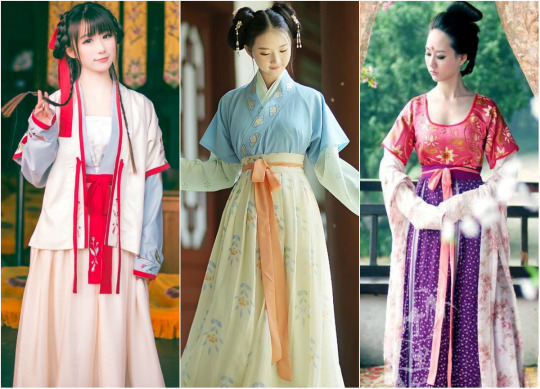
- Bijia/比甲 - a sleeveless jacket, usually worn over aoqun, that comes in various lengths and styles.

- Daxiushan/大袖衫 - large-sleeve robe commonly paired with ruqun. As its name indicates, its main feature is its broad sleeves. The length is at least 78 inches, and the width exceeds 40 inches. The material is generally thin and light, because it was originally created for wear in the summer.

Of course this doesn’t cover everything, but it describes the basic hanfu styles that appear most often on this blog. Hope this helps!
13K notes
·
View notes